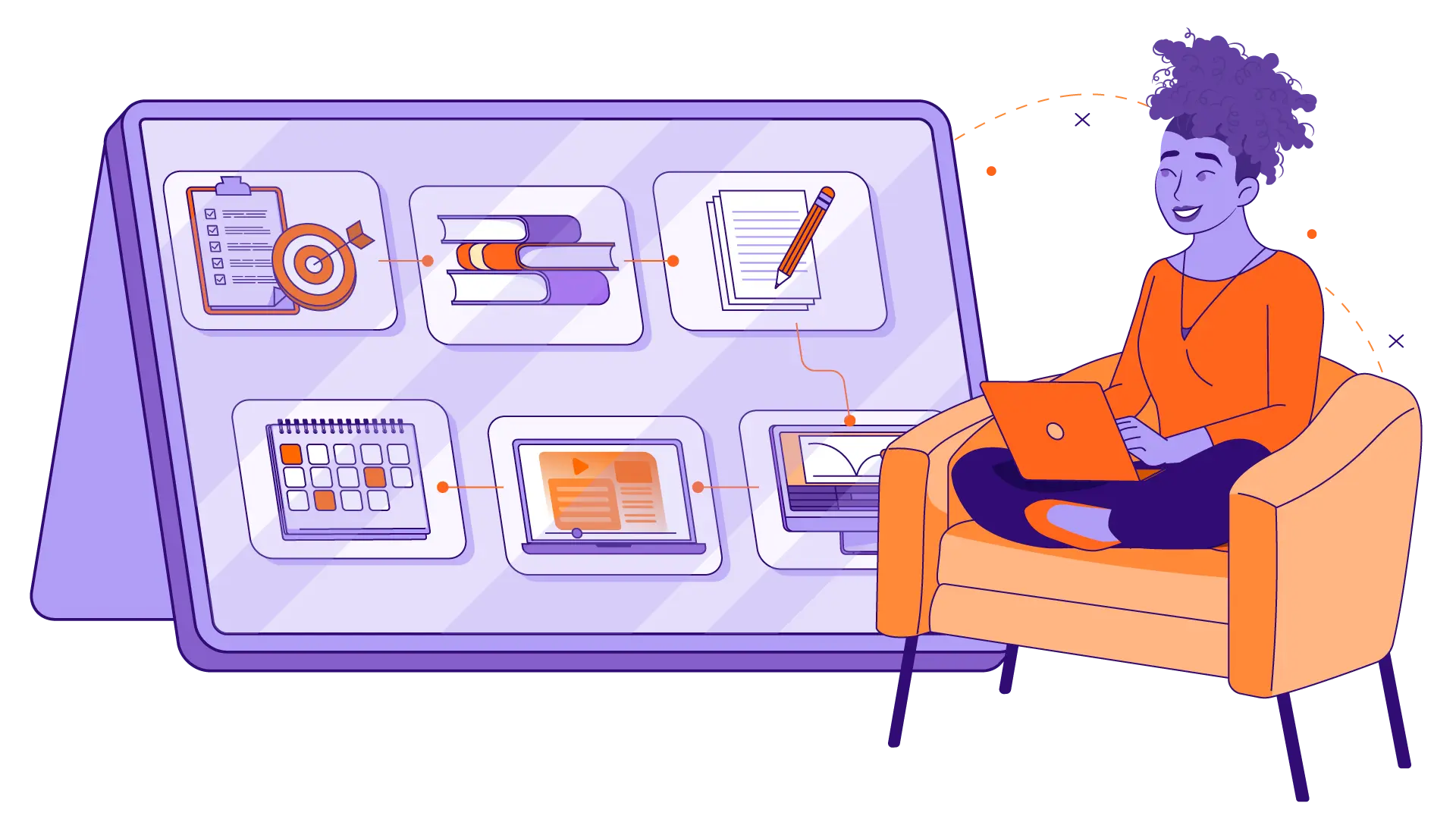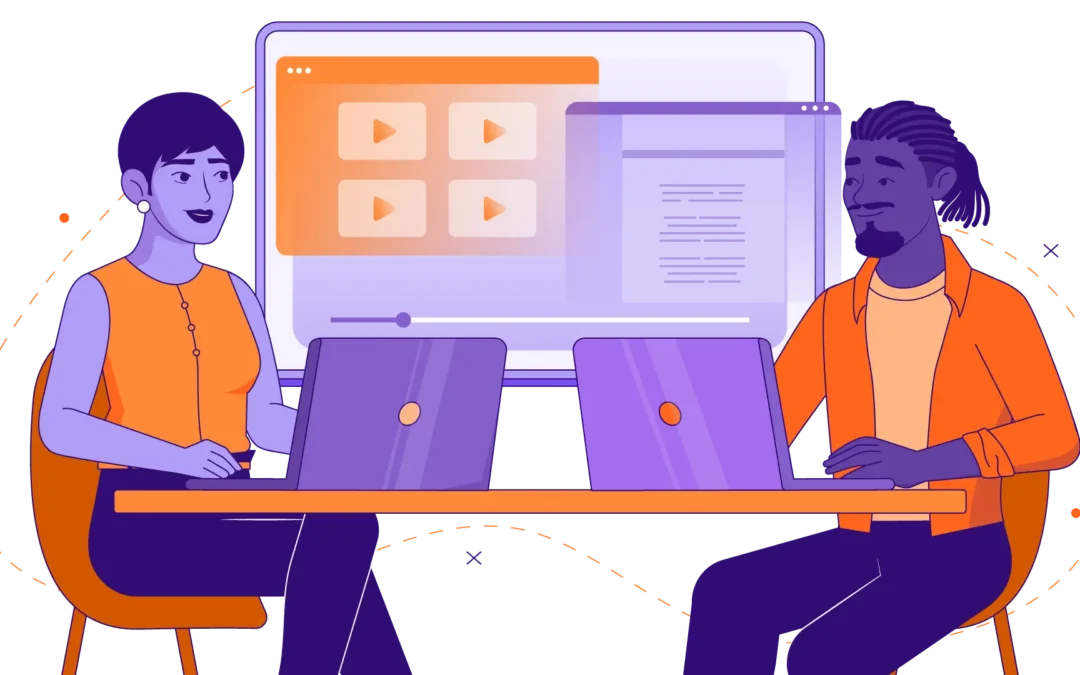
How to make effective Employee Onboarding Videos + Examples!
Employee onboarding is one of the most critical stages in an employee’s journey at your company. It’s the first real introduction to your company culture, values, and processes. The way you onboard new hires can influence their long-term engagement, productivity, and even their retention.
One of the best tools for creating an impactful onboarding process is video. Employee onboarding videos can help new employees feel comfortable, informed, and ready to succeed. But how do you make sure your videos are effective and engaging? Let’s explore the steps you can take to create powerful employee onboarding videos that your team will love.
What are employee onboarding videos?
Employee onboarding videos are short, informative, and engaging videos designed to help new employees navigate their first few days, weeks, and months at your company. These videos provide a visual and interactive way to introduce new hires to your organization’s culture, values, and key procedures.
Instead of bombarding them with text-heavy manuals, onboarding videos offer a more personal and digestible format that can be easily accessed whenever they need it. Think of onboarding videos as your company’s “welcome package” that gets employees excited, informed, and ready to contribute to the team.
Here are some additional tips for creating effective onboarding videos:
Keep them short and sweet.
People have short attention spans, so keep your videos concise and to the point. Aim for videos that are no longer than 5 minutes.
Use a variety of visuals.
People have short attention spans, so keep your videos concise and to the point. Aim for videos that are no longer than 5 minutes.
Use a clear and concise script.
Write a script for your video and practice it a few times before recording. This will help you stay on track and deliver your message clearly.
Use a professional narrator.
If you’re not comfortable speaking on camera, hire a professional narrator to voice your video.
Add music and sound effects.
Music and sound effects can help create a more engaging and professional video.
Use closed captioning.
Closed captioning makes your videos accessible to a wider audience, including people with hearing impairments.
Promote your videos.
Once your videos are complete, promote them on your company’s website, social media channels, and internal communication platforms.

Why use Onboarding Videos?
Building a customer education strategy involves several steps. Here’s how to approach it:
They Help New Hires Retain Information:
It’s no secret that humans process visuals faster than text. When information is presented through video, it becomes more memorable. New hires can engage with the material at their own pace, rewatching sections they might not have understood the first time. This ensures they retain important information.
Videos Are More Engaging Than Text:
People remember more when they see and hear things rather than just reading about them. Videos incorporate multiple learning modalities, making them more engaging than static documents. Whether it’s a dynamic presenter or an animation, videos have the power to hold attention and connect with new hires on a deeper level.
Videos Promote Consistency Across the Board:
When you have a video as part of your onboarding process, every new employee gets the same high-quality content. This ensures that everyone receives the same information, and no crucial details are left out. With video, you eliminate the risk of inconsistent delivery that can sometimes occur in traditional classroom training or paperwork.

How to Create Onboarding Videos
Creating effective employee onboarding videos involves more than just recording footage and adding a few slides. It requires thoughtful planning, clear objectives, and the right tools to ensure your videos are engaging and serve your business goals. Here’s a step-by-step guide on how to create onboarding videos that will help your new hires succeed.
1) Define the Business Goals Behind the Training
Before jumping into the production of your onboarding videos, it’s essential to define the business goals that the training is meant to achieve. Ask yourself, what are the specific outcomes you want to see as a result of this onboarding process? Do you want new employees to understand your company culture? Do you want to ensure they know how to use internal tools effectively? Are you aiming for a specific behavior change or skill development?
Understanding the big picture helps you design onboarding videos that align with these goals. For instance, if your business goal is to improve employee retention, you might focus more on videos that highlight your company culture and values. If you want employees to be productive more quickly, your videos might center around role-specific training and tools.
The clearer you are about your objectives, the easier it will be to shape your videos to meet those needs. At the end of the day, the goal of onboarding videos is to set your employees up for success, and this success needs to align with your company’s overall goals.
2) Draft Learning Objectives That Build into Competencies
Once you’ve defined your business goals, the next step is to outline clear learning objectives. These objectives should specify what employees should be able to do by the end of their training. It’s important to think about not just knowledge but also competency—the ability to perform specific tasks that are essential to the job.
For example, a learning objective for a customer service role might be: “By the end of this onboarding video, the new employee should be able to navigate the company’s customer service platform to resolve basic customer queries.” This is a competency-based objective because it emphasizes the skill and ability needed on the job.
Break these learning objectives down into bite-sized competencies that can be achieved through video content. Instead of trying to teach everything in one go, focus on key tasks that your employees will need to do regularly. Each video should aim to master one or two competencies at a time, helping your employees build knowledge and skills progressively.
3) Create Scripts That Align with the Audience
Now that you have clear business goals and learning objectives, it’s time to draft your script. A good script serves as the backbone of your onboarding video and ensures your message is delivered clearly and effectively. But here’s the key—your script must be aligned with your audience.
Think about who will be watching your video. What are their backgrounds? Are they experienced professionals or new to the workforce? Are they familiar with your industry, or is this their first exposure? Tailor the language, tone, and delivery to match your audience’s needs. For instance, a video for a tech-savvy audience can dive into more complex details, while a video for a less experienced audience may need to simplify processes and use more approachable language.
The script should also match the format of your video. Is it an instructional video with step-by-step directions? Or is it more of a culture video that highlights company values? In either case, your script should be engaging, straightforward, and free of jargon.
Use simple language, and break the content into digestible sections. Don’t forget to include transitions and calls to action, like “Now that you know about our culture, let’s take a look at how to navigate our internal tools.”
4) Use Tools That Are Within Budget and Create Something You Are Proud Of
You don’t need a Hollywood production team to create a compelling onboarding video. There are plenty of tools available that are both budget-friendly and capable of creating professional-quality content.
Start by selecting a tool that fits your budget. If you’re just getting started, you can use basic tools like Canva or iMovie to create simple, engaging videos. For screen recording, tools like Loom or Camtasia are excellent options, allowing you to record your screen and voice simultaneously. If you want to include animations or more complex editing, tools like Adobe Spark or Veed.io offer an intuitive interface and can help you produce polished content with ease.
Even with limited resources, it’s important to produce something that you are proud of. Pay attention to sound quality, lighting, and video composition. A well-lit video with clear audio goes a long way in making your onboarding content look professional and ensuring it’s easy for your audience to consume.
Pro tip: You don’t need to get everything perfect right away. Focus on producing quality content that resonates with your audience, then refine and improve it as you go. The goal is to deliver value while staying within your budget.
5) Test with a Prototype!
Before scaling up your video production, test your concept with a prototype video. This will allow you to gather feedback and make adjustments before creating a full set of onboarding videos. A prototype can be a simple version of the video—just a few minutes long—containing the key concepts you plan to cover.
Share this prototype with a small group of employees or stakeholders. Ask for their feedback on the content, clarity, pacing, and overall engagement. Do they feel that the video covers all the necessary information? Are they able to understand the material and apply it to their job? Did they find the video engaging and enjoyable to watch?
Feedback from real users will give you a much clearer picture of how effective the video will be in a real-world setting. Use this input to refine your content, pacing, and visuals before moving on to the next step.
6) Scale Up Production
Once you’ve tested your prototype and received feedback, you’re ready to scale up your video production. This step involves creating a series of videos that build on each other, helping employees grow in their competencies gradually.
Now is the time to streamline your process for creating videos. If you’re producing several videos, consider creating a video production schedule to keep things organized. You can break down the process into manageable stages: writing scripts, recording content, editing, and publishing. Having a clear timeline will help ensure the videos are completed on time and meet your quality standards.
Additionally, if you find that your videos are consistently performing well and achieving their goals, consider using the same basic templates for different topics. This will save time and keep the content production process efficient.
As you scale, don’t forget to continue testing and improving your videos. Use data from video analytics and feedback from employees to refine your approach. Over time, you’ll be able to create a video onboarding process that’s both scalable and continuously improving.

The best tool to create employee onboarding videos
Creating high-quality onboarding videos doesn’t require a Hollywood budget. With the following tools, you can create engaging content that fits any budget:
Smartphone:
Your phone camera is capable of recording HD or even 4K video. It’s an easy, no-cost solution for creating professional-looking footage.
Loom:
Loom is a screen-recording tool that lets you capture your computer screen and add a webcam feed. It’s perfect for walkthrough videos or tutorials.
Camtasia:
For those who want to take it a step further, Camtasia allows you to record your screen and add text, animations, and effects to create polished, professional content.
Canva:
Create custom graphics, animations, and titles to make your videos more engaging.
Adobe Spark:
A simple tool for creating visually appealing videos with built-in templates and easy-to-use editing features.
Veed.io:
An online video editor that makes it easy to edit, add text, and include other elements in your video.
No matter your budget, these tools will help you create high-quality onboarding videos that don’t require a big investment.
👉 Check out our award-winning portfolio and explore the endless possibilities of interactive learning 👈
6 Types of Onboarding Videos to Try [With Examples]
Onboarding videos come in many shapes and sizes. Here are six types of onboarding videos that you can incorporate into your training program, along with some examples to get you inspired:
Welcome Message:
Kick off the onboarding experience with a warm, welcoming video from your CEO or HR manager. This video can set the tone for the rest of the onboarding process by introducing the company’s mission, values, and goals.
Role-Specific Training:
Create videos tailored to each department or role. Show new employees exactly what their responsibilities will be, and walk them through important tasks they will be performing. Use screen recordings to demonstrate how to navigate systems, tools, or internal processes.
Company Culture and Values:
A culture video is essential to help new hires understand what your company stands for. Highlight the core values that shape the workplace environment. Share stories or testimonials from long-time employees to give an authentic look at the company culture.
Benefits and Policies:
Use a video to explain your company’s benefits package and key policies. This could include details about insurance, vacation time, company events, and more. By using video, you can break down complex policies in a simple and understandable way.
Team Introductions:
Help new hires get familiar with their colleagues by creating a team introduction video. This video could feature team members sharing a bit about themselves and their roles. This will help employees feel connected to their teammates even before meeting in person.
Compliance and Safety:
Create short compliance and safety videos that cover important regulations and best practices. This is especially critical for industries where safety is a concern. Use video to make sure that employees understand protocols and the importance of following them.
10 amazing employee onboarding videos
Our Employee Onboarding Videos Examples YouTube playlist is a dynamic resource designed to provide a wide variety of real-world examples for creating effective and engaging onboarding content. Continuously updated, this playlist showcases a range of onboarding videos from different industries, highlighting diverse approaches to introducing new hires to company culture, policies, and tools.
Download the Free Onboarding Video Template!
The 20 AI Prompts Employee Onboarding Video Template offers a comprehensive, easy-to-use guide for creating engaging and effective onboarding videos using AI-driven content. This template provides a set of pre-written prompts designed to cover key areas of the employee onboarding process, such as introducing the company culture, outlining roles and responsibilities, walking through company policies, and explaining key tools or software.
Employee onboarding videos are an invaluable tool for creating a positive, engaging experience for your new hires. By presenting critical information in a visually appealing and easy-to-digest format, you can increase engagement, retention, and productivity. Start with simple tools, follow the best practices, and create videos that reflect your unique company culture.
DOWNLOAD YOUR KEY TO KNOWLEDGE
Access Valuable Resources to Fuel Your Learning Journey

